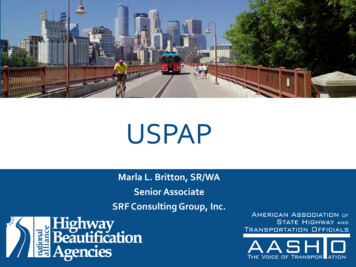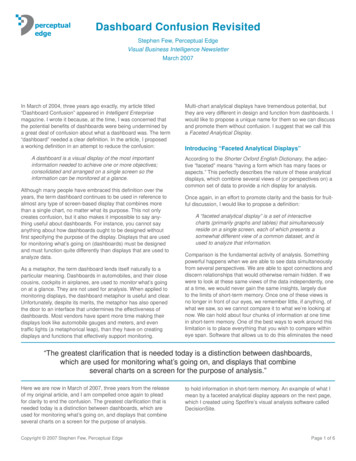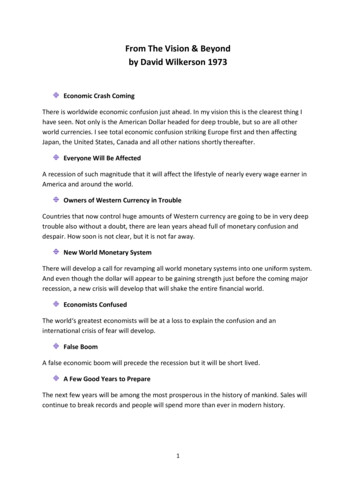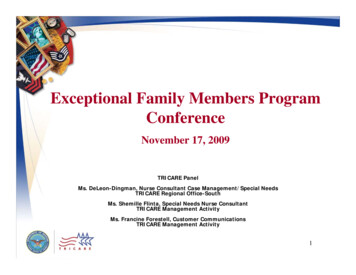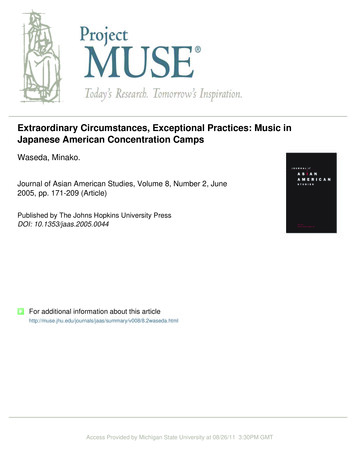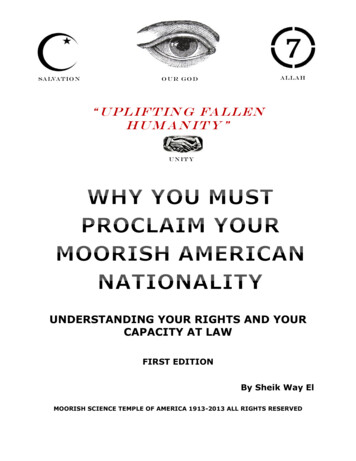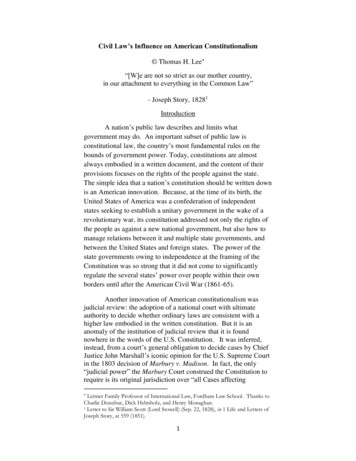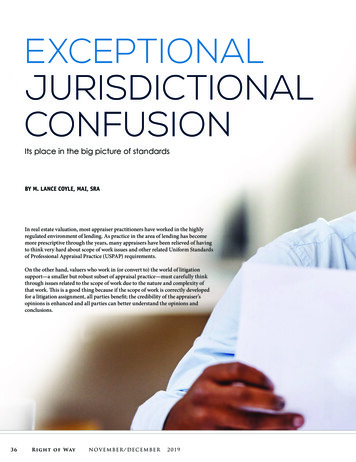
Transcription
EXCEPTIONALJURISDICTIONALCONFUSIONIts place in the big picture of standardsBY M. LANCE COYLE, MAI, SRAIn real estate valuation, most appraiser practitioners have worked in the highlyregulated environment of lending. As practice in the area of lending has becomemore prescriptive through the years, many appraisers have been relieved of havingto think very hard about scope of work issues and other related Uniform Standardsof Professional Appraisal Practice (USPAP) requirements.On the other hand, valuers who work in (or convert to) the world of litigationsupport—a smaller but robust subset of appraisal practice—must carefully thinkthrough issues related to the scope of work due to the nature and complexity ofthat work. This is a good thing because if the scope of work is correctly developedfor a litigation assignment, all parties benefit; the credibility of the appraiser’sopinions is enhanced and all parties can better understand the opinions andconclusions.36R ig h t of WayNOVEMBER/DECEMBER2019
NOVEMBER/DECEMBER2019R ig h t of Way37
USPAP's Five Big RulesThese always apply to appraisal and appraisal reviewStandards 1 through 10The Big FiveUSPAP has five big rules that applyto each and every appraisal and/orappraisal review assignment. Thesefive big rules take precedence overeverything else in USPAP. In a sense,they are superior to all the otherrequirements, acting as an umbrella overthe rest of USPAP. But it’s more thanthat; they govern which additional rulesapply and even what portions of thoserules apply.Among the five big rules, one isessentially administrative (the RecordKeeping Rule) and two are essentiallygeneral conduct-oriented (the EthicsRule and the Competency Rule). Theyare specific as to behaviors, but theyare not specific as to the mechanicsof development and reporting of anappraisal, which are enumeratedelsewhere. However, the final two bigrules (the Jurisdictional ExceptionRule and the Scope of Work Rule) workhand in hand. They are the rules thatspecifically determine how the appraisalor appraisal review is to be executed.In fact, the Scope of Work Rule directlydetermines which of Standards 1through 10 are used, as well as whatportions in those standards are needed.Jurisdictional Exception RuleThe Jurisdictional Exception Rule isa short and fairly straight-forwardrequirement. Its basic concept is thatif a valuer is absolutely unable tocomply with one of the mandatoryrequirements of USPAP due to a lawor regulation, an exception to USPAP38R ig h t of Wayis allowed for that requirement.However, the remainder of USPAPis preserved and will still apply toall other aspects of the assignmentand the appraiser who preparesit. Appraisers who work in thelitigation support arena are oftenconfused about the applicability ofthe Jurisdictional Exception Rulebecause litigation assignmentstypically involve many laws, rulesand regulations.In a litigation assignment thatinvolves a condemnation action—and depending on individual statelaw—an appraiser may be askedto ignore any changes in marketvalue that result as a consequenceof the project for which the takingis necessary or any changes thattake place in the neighborhoodfor the same reasons. Sometimes,a valuer may be prohibited by lawor regulation from reporting advalorem tax data or certain leasedata. Additionally, they might havea requirement to exclude or includecertain comparable data or zoninginformation, among many others.These requirements differ from thetypical practices that are found inappraisals prepared for regulatedlenders.One common situation that arisesoften is rooted in what is known incondemnation law as the “projectNOVEMBER/DECEMBER2019influence rule,” which essentiallystates that a valuer must ignoreany positive or negative change inthe market value of a property (inthe “before” condition) as a resultof the same public project forwhich all or a part of the propertyis being taken. However, in therequirements for the developmentof an appraisal, USPAP includeslanguage about analyzinganticipated public improvementsand their effect on value, aswell as analyzing the effect onuse and value of existing andmodified land use regulations.Specifically, USPAP Standard Rule1-4(f) states: “When analyzinganticipated public or privateimprovements, located on or offthe site, an appraiser must analyzethe effect on value, if any, of suchanticipated improvements to theextent they are reflected in marketactions.”Thus, for many practitioners,it appears a conflict exists. Theproject influence rule requiresa valuer to ignore the effect onvalue created by the projectwhich has necessitated thetaking, but USPAP appears torequire the valuer to analyzeanticipated public improvementsand their effect on value. Manyappraisers conclude that thisapparent conflict in requirementsprevents them from complyingwith USPAP and a JurisdictionalException is then created. This isa common mistake, probably as aresult of a lack of understanding
of the concept of scope of workand how the various parts ofUSPAP work together to determinethe appropriate requirements ofdeveloping an appraisal.Scope of Work RuleThe Scope of Work Rule in realestate valuation is somethingakin to the function of a recipe incooking. If the problem to be solvedis to produce a cake for a friend, Iknow I’ll need some flour, bakingpowder, eggs and other ingredients.If it’s my friend’s birthday, it mightneed some special frosting ordecoration to match the intendeduse and maybe some chocolate tomatch her particular definition ofbirthday cake. And if my friendhas special dietary needs, I mightneed to use a sugar substituteinstead of granulated sugar asa special condition. I will alsoneed competency in baking skillsnecessary to correctly identify andexecute the techniques of mixing,temperature control, timing,proper equipment and oven baking.On the other hand, if my purposeis to create a dinner entrée, suchas a Chicken Piccata, I don’t needbaking techniques at all and I don’tneed the same ingredients. Instead,I will need to know how to pansauté and I’ll need some chicken,wine and capers.In the same way, the scope of workin an appraisal assignment tells mehow to solve the problem based onthe data needed (the ingredients),the techniques employed (bakingor sautéing), the propertycharacteristics (cake or entrée),the intended use (a birthdaycelebration) and any specialcircumstances (a person withdietary restrictions), among others.In a real estate appraisal, Standards1 and 2 will be applicable resultingfrom the Scope of Work decision,while Standards 3 through 10would be ignored. A businessappraisal would use Standards 9and 10 only, and so on.Project InfluenceAmong the most criticalcomponents of developing a properscope of work in a litigation supportassignment is the requirement tofollow the “laws and regulations”applicable to the assignment.These are just three little wordsburied in one paragraph and theirimportance is often overlooked.In a condemnation appraisal, theproject influence rule is usuallyan overarching and importantrequirement. It is exactly what ismeant by “laws and regulations”that are identified in the Scope ofWork Rule. Remember, the Scopeof Work Rule has precedence overthe Standards Rules 1-10, so if therules and regulations applicableto the assignment prohibit thevaluer from analyzing “anticipatedpublic or private improvements,located on or off the site,” then thatrequirement takes precedence overany requirements found in Standard1 and that portion of the standard issimply ignored. In a similar fashion,the rules and regulations applicableto an assignment prepared for taxappeal litigation must be followed.Rules and regulations applicable toan environmental contaminationcase are another example. This iswhy understanding the Scope ofWork Rule is so important in anytype of litigation case.However, this still does not answerthe question concerning the creationof a Jurisdictional Exception. Can theappraiser fully comply with USPAPwhen these seemingly conflictingconditions exist?EvolvingValuation standards have evolvedand changed through the years,including the fundamentalmechanics of how they work. For along period of time, the requirementsof Standard 1 were mostly mandatoryand many valuers seem to havethis idea still firmly embedded intheir consciousness. This is part ofthe reason for current confusion.Later, the idea of “departure” wasintroduced, giving valuers moreflexibility in how appraisal opinionswere developed and introducingthe idea that some requirementsare contingent, depending on theproblem to be solved. Departure waslater dropped in favor of the moreelegant and sophisticated scope ofwork concept.With this evolution in standards, notall of the requirements enumeratedin Standard 1 are mandatory today.In fact, some are “contingent.” Forsome reason, the contingent aspectsof Standard 1 are lost on manyvaluers.Defining ContingencyWhat does the word “when” mean?This might seem like an innocuousquestion due to its common usage,but the word “when” is used liberallywithin the standards. In fact,the word “when” appears at thebeginning of a sentence 12 times inStandard 1 and is one of the keysto understanding how to executeappraisal development once the scopeof work is correctly developed. Thefact that the word is so commonlyused in everyday English leads tocomplacency regarding its use in thestandards, which creates confusion.The word “when” is mostly definedin the dictionary in terms of a timeconcept; this is how it is used in thecommon vernacular. Here’s justone example of how it is confusing:Standards Rule 1 states in 1-4(a):“When a sales comparison approachis necessary for credible assignmentresults, an appraiser must analyzesuch comparable sales data asare available to indicate a valueconclusion.”A casual reading of this USPAPpassage could easily be interpretedby a valuer as being something likethis: “I’m going to write up my salescomparison approach today andwhile I’m doing that, I need to beNOVEMBER/DECEMBER2019R ig h t of Way39
sure to analyze such comparable salesdata as are available to indicate a valueconclusion.” But this is wrong and isnot what the word “when” means in thecontext of appraisal standards.The word “when” in USPAP reallymeans “if” and it establishes that someof the clauses in USPAP Standard 1are contingent. An expanded conceptof the word “when” might also meanthe following: “If needed for credibleassignment results established underthe Scope of Work Rule.” The word“when” is not a time concept in USPAP;it is a contingency.USPAP RequirementsAn analysis of Standard 1 reveals 24requirements that are must-do’s. Thereis no contingency and no option. Forinstance, an appraiser must not commita substantial error, be careless ornegligent, identify the client, identifythe definition of value and so on.However, there are 19 clauses that arecontingent on the scope of work and inthe case of the project influence rule ina condemnation case, Standards Rule1-4(f) is one of them. The very first wordof the SR 1-4(f) clause is “when,” butnow we understand that it really means“if.”Circling back, remember that the Scopeof Work Rule requires that valuers followthe laws and regulations applicable tothe assignment. In a condemnationappraisal, if the laws and regulationsrequire the valuer to ignore an analysisof anticipated public or privateimprovements and their effect on value,then that portion of USPAP Standard1 is not applicable at all and would notbe done. And because this portion ofUSPAP is contingent on the scope ofwork, there is no departure from therequirements as it is not a mandatoryrequirement. In fact, complying withthe laws and regulations in the Scopeof Work Rule means that the valueris proactively complying with USPAP(not failing to comply) because thescope of work specifically excludes theanalysis of anticipated public or privateimprovements. Perhaps it would beillustrative to think about the meaningof USPAP Standard 1-4(f) along theselines: “If it is necessary under the scopeof work to achieve credible results,analyze anticipated public or privateimprovements and their effect on value;if the laws and regulations applicableRemember that ajurisdictional exception is createdonly when the law or regulationprevents the appraiser fromcomplying with the Standards.40R ig h t of WayNOVEMBER/DECEMBER2019to the assignment prohibit analyzingpublic or private improvements, thenignore anticipated public or privateimprovements.” Thus the valuer cancomply with the requirements of USPAPand no jurisdictional exception is created.A Closer Look at JurisdictionalExceptionsRemember that a jurisdictional exceptionis created only when the law or regulationprevents the appraiser from complyingwith the Standards. The project influencerule does not create this condition, asUSPAP is structured so that the appraisercan comply. The combination of theScope of Work Rule and the concept ofhypothetical conditions (which are a partof problem identification in the Scope ofWork Rule) allow exceptions to standardsrequirements.Along with general assumptions,extraordinary assumptions, hypotheticalconditions, and laws and regulations,jurisdictional exceptions are consideredan “assignment condition.” Assignmentconditions are one of the criticalassignment elements that must beidentified in order to satisfy USPAP’srequirement to recognize the problem
to be solved. If the laws and regulationsin an assignment are properly followedand it is clearly established that ajurisdictional exception does not exist,are any further disclosures, conditionsor requirements needed? Some arguethat use of a hypothetical conditionis duplicative since that portion ofUSPAP is not applicable if scope of workis correctly developed and followingthe laws and regulations satisfies therequirement to properly account forassignment conditions. However, ahypothetical condition explaining thatthe project doesn’t exist when in factit does, helps to clarify and inform thereader of how the valuation problem isbeing undertaken. It also demonstratesthat the appraiser understands and iscomplying with the project influencerule. Further, in the case of an appraisalprepared for eminent domain acquisition,it is usually necessary to include ahypothetical condition that any “afterthe taking” valuation assumes that theproject has already been completed onthe effective date of the appraisal.Yellow BookThis is not the end of the confusionregarding the Jurisdictional ExceptionRule. If you are an appraiser providingvaluation services for the condemnorin a federal acquisition, you are subjectto and must comply with the UniformAppraisal Standards for Federal LandAcquisitions (UASFLA), often calledthe Yellow Book. In the section titled“Consideration of Land Use Regulationsand Anticipated Public Projects,” theUASFLA advises:Section 1.2.7.3.3 of these Standardsprovides that the appraiser disregard anychanges in a property’s neighborhoodbrought about by the government’sproject. Section 1.4.3 further instructsappraisers to disregard recent rezoning(or the probability of rezoning) of thesubject property if such action was theresult of the government’s project. Section4.3.2.4.1 (Exceptions, under Zoningand Permits) explains the legal basis forthese instructions. These instructionsare contrary to USPAP Standards Rule1-3(a), which requires appraisers toidentify and analyze the effect on use andvalue of existing land use regulationsand probable modifications thereof,and to USPAP Standards Rule 1-4(f),which requires appraisers to analyzethe effect on value of anticipated publicimprovements located on or off site.Therefore, the instructions to appraisersin these Standards in this regard areconsidered jurisdictional exceptions.explanatory paragraph in the appraisalreport where scope of work issues arediscussed may also be worthwhile.In SummaryWhen valuers provide litigation supportservices they also often provide relatedexpert witness testimony and standardsare often ignored or minimized.Standards can be confusing, hard tounderstand and for many participants,just plain boring. Some lawyers take theposition that testimony about standardsis simply not persuasive from a tacticalperspective. Some lawyers don’t investthe time necessary to understandthe standards. Some administrativelaw judges or special commissionersmay prefer to hear testimony that isfocused on valuation issues, ratherthan “technicalities” in appraisalstandards. But if the issue of standardsis in play and if opposing counseldiscovers that standards have not beencarefully followed, not only will a valuerexperience a very uncomfortable sessionon the witness stand, but the valuer’scredibility will be impacted. Imaginea medical malpractice case where themedical provider did not follow standardprocedures of care. There is no reasonfor parties of a condemnation case tobe confused about the JurisdictionalException Rule. JUnfortunately, these instructionsfound in the UASFLA manualidentifying the need to ignore SR1-4(f) as a jurisdictional exceptionare incorrect, as we know from thepreceding explanation. This furtherconfuses the public and appraisalpractitioners. Notwithstanding, valuersshould follow client instructions andregulations, including the requirementsof the UASFLA. The UASFLA is anassignment condition that should becomplied with, as it is one of the lawsand regulations that are applicableto the assignment. There is no singleway to handle this conflict with theclient, but communication with theclient is paramount, particularly withregard to scope of work issues and howthe appraisal is to be prepared. AnNOVEMBER/DECEMBERM. Lance Coyle, MAI, SRA served as the 2015President of the Appraisal Institute, as wellas on its Education Committee and Body ofKnowledge Committee. A member of the AIfaculty, he has over 30 years providing valuationservices, mostly in Eminent Domain casesand today offers appraisal reviews of reportsprepared in litigation cases.2019R ig h t of Way41
requirements of USPAP due to a law or regulation, an exception to USPAP is allowed for that requirement. However, the remainder of USPAP is preserved and will still apply to all other aspects of the assignment and the appraiser who prepares it. Appraisers who work in the litigation su
